This text-based course is a transcript of an AudiologyOnline live e-seminar presented by Cochlear Americas as part of their online HOPE series. To view other HOPE courses, please visit: Cochlear Online Courses. Please download supplemental course materials.
Ashley Garber: Welcome to our presentation today. This is a "freshened up" presentation, based on one we did for you last year. This particular presentation has been archived for some time, but we decided to take another look, freshen it up, and add a few activities to the existing program. This is will now take the place of the currently archived session. I am Ashley Garber and I am joined today by Mary Ellen Nevins. Donna Sorkin, VP of Consumer Affairs for Cochlear Corporation, cannot join today, but she would like to assure you that Cochlear's commitment to education outreach is underscored through programs like this. We do have many online sessions to offer you, because Cochlear feels that you as educators are a very important piece of the rehabilitation puzzle for children with cochlear implants. We are committed to help you learn as much as you can.
I would like to introduce us again to you. My name is Ashley Garber. I am a speech-language pathologist and I have over 15 years of experience with children and adults with hearing loss and cochlear implants. Currently I practice in a private practice in Ann Arbor, Michigan. I am joined today by Mary Ellen Nevins. She is an experienced teacher and teacher educator of deaf children. She has been in the field for many years. Mary Ellen has three books out on cochlear implant and related subjects regarding children. You can check those books out through Plural Publishing Inc. if you are interested.
I would like to share with you the agenda for today. We will first begin by presenting you with a model for observing auditory developments that will look at three components: Auditory Function, Language Input, and Situational Context. Then we will discuss how to get started in using a model like the one that we will give you. We will then put all of this together with some case files that we have developed as well some activities for each of the children that we describe to you today.
Let's begin by considering the model of auditory skill development that Mary Ellen and I have developed for you. This is something that a number of professionals have written about over the years, most notably Norm Erber who presented his auditory skills hierarchy, the Listening Triangle, which you may be familiar with. There are slightly different versions of this basic auditory function throughout the literature over the last many years. From our combined experience we have found utility in looking at three parameters and considering them slightly differently; we will present this for you today. The three parameters are auditory function, meaningful input, and situational context.
Auditory Function
First we will discuss auditory function and the different levels on the hierarchy of functional skills. On the base level, the basic auditory skill would be the skill of detection. By this, we mean demonstrating the awareness of a particular sound or sounds, regardless of whether it is a speech sound or an environmental sound. Next would be the skill of discrimination. I think is a term that is misunderstood or used differently by different people. In its truest form, discrimination means making judgments between two sounds as to whether those sounds are similar or different. This is comparing two sounds one to the other whereas identifying is a slightly higher and different scale, which we will discuss in a minute. Patterning is the recognition of features of rate, duration, intensity and pitch. These are features that create rhythms in sounds and speech, and examples are our tone of voice, how fast we are speaking, how loudly or softly, high pitch or low pitch. This would be the patterning skill.
Identification is where discrimination can be confused. When we use the term identifying, we mean specifically indicating what sound has been heard or what word has been heard. This is either a motor response such as pointing to a picture or object that represents the sound or word that is heard, or a speech response by imitating what has been heard. Comprehension is the most complex of these skills. This is demonstrating understanding of the input through response or generation of new ideas. This could be a child answering a question or responding in a way that shows you that they have taken what they heard and have been able to move on by generating new ideas.
Throughout this discussion, we are going to build our model visually for you so you can see how the five auditory function levels which I have described are placed on a continuum with the base skill on the left moving toward the more complex skill on the right, from awareness through comprehension (Figure 1). As we build each parameter, we will build the model piece by piece.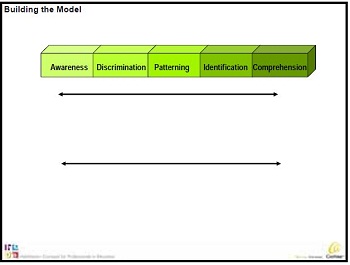
Figure 1. A visual model of auditory skill development showing five auditory function levels on a continuum, with the most basic skill on the left and the most complex on the right.
Meaningful Input
Meaningful input is the linguistic or auditory input that we are considering, begining with sounds, such as environmental sounds or speech sounds. Then we would move to words, phrases, sentences, and with the most complex level being conversation or connected discourse (Figure 2). If we plot this again on the auditory function level that we described above, you will see that sounds are the most basic component and will be on the left. We move towards the more advanced skill of conversation or discourse on the right.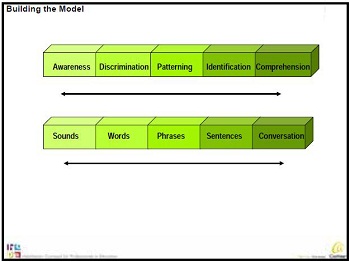
Figure 2. Meaningful input is required for auditory skill development. The lower bar in this figure shows a continuum of input from the most basic on the left, and the most advanced or complex on the right.
Situational Context
The third parameter that we have chosen to discuss is the one that is not often integrated into an auditory model, at least not the visual representation of that model. We would propose to you that situational context is a third parameter to be considered when thinking about auditory function. By this, we mean from simplest to most complex would be first structured listening tasks or when we have specific activities that are designed to practice auditory skills. This can be a closed set task where all the listening choices are available. This is a familiar activity where we ask a child to select from four objects or picture cards, for example, a ball. A bridge set would be more complex. We are still talking about a closed set of objects, but perhaps these are given through description of a topic or a category, so that the set is a cognitive set versus a visual set. An example would be if I asked you to consider that I will be naming an animal. In your mind you have a closed set of the names of animals. I will then name one to you. You still have a closed set of information, but they are not visible to you. They are instead a cognitive set that you have in your mind, a set that can be decreased if I tell you I would like you to "think of a farm animal" or increased if I say "any animal that you know". The open set is greater still. This is the set where possibilities for the stimuli that you are targeting are endless. I do not give you any information as to what you are listening for.
Slightly more complex or more natural than tasks in the structured context would be routine activities. Routine activities are those events that are associated with predictable language. Natural exchanges are even more natural where we are using real world conversations that are goal-oriented. We ask the child to listen and that ability to listen is going to transcend the environment or activity. This is a natural situation in language where we will be asking the child to listen and respond. If we plot this versus the other parameters we have mentioned before (Figure 3), there are three bars with auditory function at the top, meaningful stimuli in the middle, and now our context is plotted along the bottom. As we describe this further, I would like for you consider if we visualized that we could take a piece of paper and cut out each of these bars, we can manipulate them relative to one another so that we can create our goals.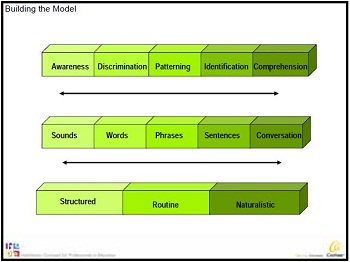
Figure 3. The lower bar in this diagram represents the situational context required for auditory skill development, from the most basic context on the left, to the most complex on the right.
With this visual in mind, we would like to emphasize that auditory function is not going to override the best practice principles that we have for language development. We know that in language development we are looking for simultaneous top-down and bottom-up approaches to working towards language. We do not want auditory function to override those principles. In other words, we know that auditory function is going to develop from the most basic skill, detection, to the most advanced, comprehension. But we want the input that is used to target that development to be varied so that we include all elements of stimuli from sounds to conversations, and conversations to sounds, as well as working throughout all situational context. Common practice suggests that auditory function develops first in a structured task and then moves to naturalistic context, but with the cochlear implant, we think that auditory skill development is possible in those more naturalistic environments from the beginning. We do not want to forget that we can target as a goal the recognition of conversational speech or identification of conversational speech for a child that has only recently been implanted and is perhaps working in a structured way identifying and working towards comprehension of words.
Let's look at the model again to visualize this. The base skills are now indicated by a gray color whereas our higher level skills are indicated in yellow. We would like for you to consider that we do not have to begin with awareness of sounds in a structured environment and move one step over on the model piece by piece until we advance to comprehension of conversation in a naturalistic environment. Instead from the very beginning, we can manipulate the model so that we can look for a child to be aware of sounds in a structured environment. At the same time, we are working towards awareness of sounds in a naturalistic environment, awareness of conversation in a naturalistic environment, or for the child to know that what she hears is another person talking. We can target that skill from the very beginning.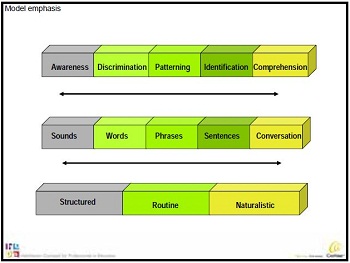
Figure 4. A visual model of auditory skill development, indicating the auditory function (top bar), input (middle bar) and situational context (lower bar) required, with base skills shaded gray, and higher level skills in yellow.
Identify the Current Auditory Skill Level
Our suggestion for the first action you take is to identify the child's current auditory skill level. Perhaps we are speaking of a child who is newly implanted and that speaks to a certain level of auditory skill development, but you may be working with a new child who has had some access. Either way the first step would be to identify the current auditory skill level by communicating with the cochlear implant center. For example, you can ask them for the results of speech perception testing which is fairly routinely performed for children that have received cochlear implants. The center can provide you with different tests and the interpretations of those tests. You can also perform functional auditory assessments on your own. Within your therapy setting or in your classroom, you can use auditory instruments such as the SPICE (Speech Perception and Instructional Curriculum Evaluation) (Moog, Biedenstein, & Davidson, 1995) or the APT-HI, Auditory Perception Test for the Hearing Impaired (Allen & Serwatka, 1994). These are two different auditory skill measures that we have identified for you. The references for these programs are listed at the end of the presentation. The SPICE program has a placement test at the beginning and then some activities that will lead you through auditory skill development as does the APT-HI. You can use something like this in your classroom to work one-on-one with the child to identify which skills they already display. Another suggestion we would offer for you is use of a protocol such as the CASLLS. This is the Cottage Acquisition Scales of Listening, Language and Speech (Wilkes, 2001). It is not solely an auditory measure, but it is a program that considers auditory skills along with language and speech development. This would be one that you may find helpful.
Note Language Abilities
We also suggest that you note the child's language abilities to inform your work on auditory skill development as well. You can administer standardized tests to gain information on this. Analyzing a language sample would be very helpful in looking at a child's communication in a naturalistic environment, how they communicate with you in one-one-one, and how they communicate with other students. A language sample would give good information on spontaneous versus imitative versus answering of questions. We would also suggest that you identify acquired, emerging, and developing language competencies. Make sure you know which things are solidly developed for a child versus something that they have just recently demonstrated some affinity for. Be sure to note the differences in their language skills.
Insure Relevance of the Goals
Then we want to think about insuring the relevance of the goals and the way we target those goals when thinking of auditory skill work. First we want to consider that different children are going to enter this implant process with different world experiences and different cultural backgrounds. They bring many different experiences to this process. Taking note of that and integrating in the things that they are familiar with into your auditory work will help you to make sure that your work is relevant as well as getting more bang for your buck by working on something that is important to the child, interesting or relevant to their home life. On the same note, we can work towards using themes that are used in the classroom. If you are an individual service provider and you are responsible for pulling the child away from the classroom to work on auditory skills, we would suggest that you really work to incorporate classroom themes into that work. In that, you are starting from the beginning and building towards that most natural of situational context. In a structured way, you are working towards something that is meaningful in the classroom. We also need to recognize that different communication contexts have different demands for a child. The structured environment will be much easier to navigate because we are one-on-one with the child, whereas in the classroom situation, the child is working to communicate with the teacher and the other students, paraprofessionals, or classroom assistants. Home is made up of very familiar listeners and communication partners, but with a variety of different demands of noise and changing situations. If we think about how different communication contexts are demanding for a child, it will help us to determine how best to address goals as we encounter them.
We are coming from the standpoint that perhaps you are a professional who has already been working with children on auditory skills or are working on speech. Now you are called upon to integrate auditory skill development into the typical lesson plan that you have already developed for a child based on their language or their speech goals. If you start with a typical lesson plan, we would ask you to assess whether your plan considers auditory skill, language level, and situational context as elements that are variable. You can manipulate the complexity of the language that you use. For example, you can manipulate how structured an activity is that you present to a child in a one-on-one setting or you can make an activity designed for the classroom more or less structured within that environment. If you think of these elements that you can manipulate this will be a good starting point for you. This will help you to design appropriate activities, but also to use challenging strategies as well. If you begin an activity that becomes too difficult, you can drop back a little by making one aspect slightly more supportive for the child. If the child is doing quite well, you can challenge them further by making something more difficult. For example, you could work towards moving something into a more natural setting if they are doing well in a routine setting. The intent here is to maintain skills that have already been acquired, practice skills that are just emerging, and then work to develop new skills in these relevant and motivating activities. Keeping what we have and solidifying those new skills, while we are bringing new skills to the forefront are our overall goals.
All school based professionals will have a role in working on auditory skill development for children with cochlear implants. No matter whether you are a teacher of deaf children, a speech-language pathologist, an itinerant teacher or teacher consultant, you will have a part to play in this development. We want to emphasize that listening and talking should be embedded into all aspects of the child's school program, but it may be beneficial at certain times for certain professionals to target specific skills in a particular context. If you are working together, you will be best positioned to determine whether the speech-language pathologist for example is going to work in the one-on-one setting on particular skills to work towards achievement of those skills in the structured environment before you work to incorporate them into the natural context.
We would like to look at some of our case files of children we have encountered over the years.
Andy
We introduce you first to Andy. He is a 4-year-old child who has been using his cochlear implant for 3 years. He received amplification soon after he was identified with a hearing loss at birth. He is a typically developing youngster with age-appropriate cognitive and motor milestones. He is currently participating in a preschool program with hearing children. We will use our model to look at his current auditory skill levels, and then we will use those levels to project forward as to what we will work on next for Andy.
Looking at this current auditory function, in a structured environment, the cochlear implant center reports that he has open set comprehension of questions. During speech perception measures, he scored very well on tests that looked at this comprehension of questions in an open set. From classroom observations we see that in the natural context, he is able to follow multi-element directions and answer questions about stories. In terms of his language level, standardized scores on vocabulary and language measures are within normal limits. He is doing quite well in his language development. In natural environments, this 4-year-old is communicating in 6 to 8 word sentences. Figure 5 shows what Andy's auditory function looks like on our model.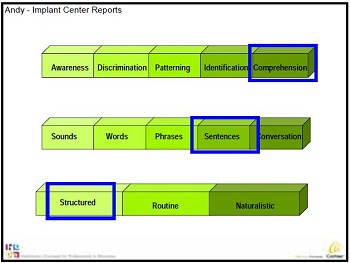
Figure 5. Andy's auditory function indicated by blue boxes in the auditory skills model.
As you remember in a structured environment, the implant center reported that he had open set comprehension of questions. In Figure 5, we have highlighted in blue that his auditory function was comprehension of questions (sentences) in a structured environment. Again the blue squares in Figure 5 show his current ability as measured by testing at the implant center.
Figure 6 shows Andy's current abilities based on classroom observation. In this case we found that Andy was able to follow multi-element directions and answer questions. In figure 6, we highlighted his auditory function which is comprehension for sentences and questions as well as conversation in a natural environment. He is doing this in discussion with peers in the natural classroom environment.
Figure 6. Andy's current auditory skills based upon classroom observation, indicated by blue boxes.
Andy is doing quite well with his auditory skills, but we consider that there are still things to work on for him. One suggestion we would make to his proximal auditory goals is introducing listening in noise with familiar context. By that, we mean listening to favorite stories. In a situation that is comfortable for him with a story he already knows, we would introduce listening in noise. We would also suggest continuing to work on vocabulary accrual. Remembering that his vocabulary skills are within normal limits, we would suggest using auditory only presentation for those vocabulary words and that we manipulate the context as needed to make sure that he is getting rich exposure to vocabulary words and is applying those words in different contexts. We would present phoneme contrasts for him at the word and sentence level. He is doing very well and comprehending sentences and words, but experienced children still often have some fine discrimination difficulties. We will work to contrast those for him so that he is developing better discrimination skills at the sound and word level. We also want to make sure that we do not overlook developing precision in articulation and overall intelligibility for Andy. These are some goals that might be suggested for a child like Andy who has had several years of implant use, was implanted at a young age, and one who is doing quite well. These are fine-tuning skills that we can do for him.
Let's plot these goals for Andy. The blue squares are the goals he already achieved that we observed in the structured environment (Figure 7) from his implant center testing. We already know that he understands questions and sentences in the structured environment through that test. We want to continue in the routine environment and add noise. This is one step further and is shown with red squares. We have manipulated only one element on his auditory model working towards routine situations for that comprehension of sentences.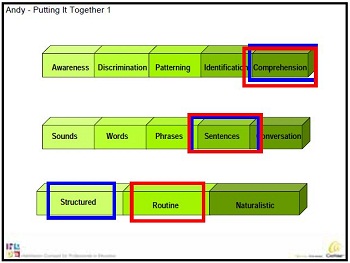
Figure 7. Blue boxes indicate auditory skills goals that Andy achieved; red boxes indicate new goals, that are progressively more difficult.
Figure 8 shows the next mapping of goals for Andy in terms of suggested vocabulary growth for him. We already know that he understands sentences and conversation in a natural environment (blue squares). We do want to work further on single words, because we know that vocabulary development is going to be very important for him as he moves through the academic years to Kindergarten and First Grade. We will continue his vocabulary development. It may look we have moved back, but this means we are focusing intently on a particular area. The red squares are the new goals of understanding of words in a structured, routine, and naturalistic environment. Depending upon the new words he is encountering, he may encounter them first in story books which may be a routine or familiar environment. Then we would use those same words in the classroom which is the natural environment. He may need a little help with certain words. We would then pull them out for practice in a structured way where we very specifically indicate what different words mean for him. We take those words into structured one-on-one settings. Hopefully this will give you a visual representation of how you can manipulate the different parameters to find the next goal and then address those goals.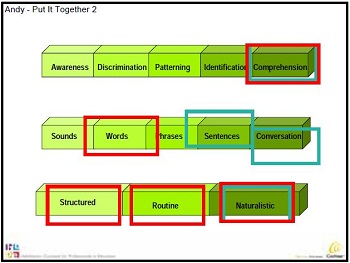
Figure 8. A mapping of Andy's goals based on the visual model of auditory skill development.
Let's think about some activities for Andy on how to build vocabulary within a familiar routine. You can read the story Sheep in a Jeep (Shaw, 1988) together in the classroom and suggest that his family also read this book with him at home. There are many higher level words included in that book. In the natural setting we can take some of those words and use them for fun games and activities for him. We can explore the house looking for things that are steep, deep, gooey or in a heap. These are all vocabulary words that pop up in this story. We might think of things that make you weep or count jeeps that we see on a car ride. Those could be activities you suggest for Andy's family. Within a structured setting, we can play Concentration or "Memory" with illustrations that show some of the targeted vocabulary so that he has to match pictures that correspond with the new words that he is learning from this story.
The last goal level for Andy was to work on fine discrimination skills between phoneme contrast at the word and sentence level. This is a new goal and not necessarily based on information directly gained. We do know that he is doing quite well and is at the comprehension level for sentences and conversation. We know that we need to be mindful of particular discrimination confusions for Andy. We will work in a structured way on discriminating words and sentences. If we take this a step further to activities we could use, let's consider the vocabulary that I suggested from Sheep in a Jeep. These are all rhyming words, so there are minimal pair contrasts that we can use during retelling. Some of these pairs would be "weep" vs. "heap", "beep" vs. "deep" - examples in which the words have initial consonants which vary by place cues; this can be difficult for children with cochlear implants, and "sheep" vs. "cheap" where the words have initial consonants that vary by manner changes - possibly something Andy confuses. We can pull these out and practice listening to them during retelling of that story. We could also in a structured setting create a game perhaps where Andy would run to the front of the room to grab a picture when he hears the phrase "sheep in a heap" or "sheep in a jeep". He would pull the picture for "heap" or "jeep" when he hears it in a sentence.
Brittany
Brittany is the second of our example children. She is 8-years-old and has had her cochlear implants for two years. Prior to cochlear implantation she was a steady language learner. She relied on sign and speech reading to supplement the information that she got from her hearing aids. This is her first year participating in an auditory oral classroom. We will look at her current auditory levels and plot those against the model that we have presented you with.
Her auditory function is at a structured setting. The cochlear implant center reports patterning in words and identification of words with vowel contrasts. She does have difficulty identifying words presented in minimal pairs. These would be test results that you would receive from the implant program with different tests for each of those areas. In a natural setting, Brittany is able to identify key words and phrases in routine activities. She can understand highly familiar questions in an open set if the context is familiar to her.
In terms of Brittany's language, she is inconsistently using complex sentence structures. This was noted on structured testing. Observations show that she is able to string together six or more content words, but she does not use the syntactic elements that are going to be necessary to create complete utterances.
You will recall that her structured testing indicated that she was able to successfully pattern words and identify words in a structured setting. These are the results from the cochlear implant center. Classroom observation indicated that Brittany was able to identify key words and phrases if she was in a routine environment or doing routine activities where the context was specific and routine. We also noted in the classroom that she was able to understand sentences or questions in the open set as long as the environment was familiar and quite routine for her. She is not showing any comprehension skills in the natural environment. This is where we would move forward.
What we would like to suggest as next goals for Brittany are presenting large closed set word identification tasks using consonant differences, with minimal pairs to further her word identification skills. We will work on embedding those words into sentences. We will also encourage closed set identification using familiar material and then we will work towards open set comprehension of things that are familiar, but in novel context. This would be using highly familiar stimuli such phrases, words, and sentences, and try to move that into a natural context for her.
Let's plot these goals for Brittany. Again indicated in blue on Figure 9 you see the skill levels we started with. Brittany was able to pattern and identify words in a structured setting. Now we are going to continue to work on identifying words and continue in a structured setting, but we are going to move her towards sentences. We will work using more auditory stimuli and more language.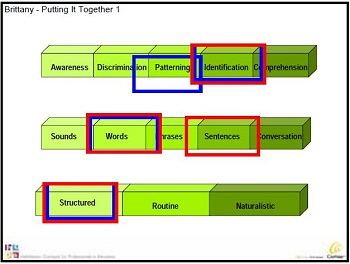
Figure 9. A mapping of Brittany's auditory skills and goals for further development.
In her classroom content, they are working on the solar system. The teacher could create listening opportunities that will target particular goals such as identifying planet names from a closed set of all of the planets. The teacher may also decide that she could work on listening to known prompts. Examples would be "this is the largest planet" vs. "this is the smallest plant", and Brittany would indicate whether it is Pluto or Mars. Those prompts are known ahead of time and Brittany will listen and choose.
Our second set of plotted skills and how we might move forward are shown in Figure 10. We described that Brittany was able to identify words and phrases if she was in a routine or familiar setting. We will continue with that at the sentence level again in routine settings. One example of an activity that we have described would be having the teacher come up with new and innovative ways to call children to line up. The teacher will be using predictable prompts. Once she starts this, it will then become routine for the children and we are embedding different words from a closed set, but it is more difficult because the sentences are larger, and we will use them in routine. Hopefully Brittany will have success listening for "Girls with sneakers, Line up", "Boys with sweatshirts, Line up", "Girls with long hair, Line up", "Boys with blue jeans, Line Up." You can see that girls and boys are contrasted as is long hair, blue jeans, sweatshirt, and sneakers. As we mentioned before, one key to working towards auditory field development and maximizing you efforts is to remember these are all variables that can be manipulated. We can make this particular task more challenging by varying the linguistic environment. "If you are a boy with a sweatshirt, join the line now." The information is the same, but we are embedded into a longer sentence. Once she is successful with the shorter sentence on the embeddings as they stand, we can make this more challenging or her.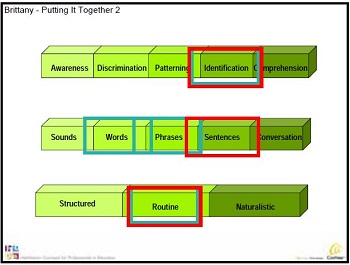
Figure 10. A further mapping of Brittany's auditory skills and goals for development, as therapy progresses and skills are achieved.
Looking now at our third goal level: Brittany was doing well, understanding sentences in a routine environment and we want to make that more challenging by moving toward the naturalistic setting for familiar sentences, working towards novel context. For example we might make a point to ask Brittany conversational questions throughout her school day. These should be questions she should be familiar with such as "What did you bring for lunch today?" If we ask this at lunch time, that is a routine that she is familiar with. Now we want to take that question and ask it at the beginning of the day. Hopefully she will recognize and understand this question outside of the usual context. Other questions could be "Did Nate say any new words yesterday?", "What will you be for Halloween?", "Are you doing anything special this weekend?", or "How was the soccer game?" For your own children, you want to pick out some familiar questions, but move them to different unexpected times of the day so it is a new context for them.
In order to assess and develop auditory skills, we would suggest that you consider these three parameters: Auditory Function, Meaningful Input, and Situational Context. The context piece is a very important piece that is not always indicated on the auditory skill hierarchies that are published and available for you. Situational context does play a real role in auditory skill development. Auditory function will develop hierarchically, but if we manipulate the input over the various contexts, we ensure that we are integrating our skills and are generalizing our auditory skills. We do move from simple to difficult in terms of awareness to comprehension, but we want to manipulate the input we are using with sentences, words, conversation. We also manipulate the context so that children are generalizing skills more quickly. Hopefully the case studies have illustrated some examples of how you can work across the parameters at any one time. The different goal levels that we suggested you move to are working on all of these things at the same time.
Cochlear Americas offers some resources that you may find helpful. The Hear We Go CD is one that offers structured listening activities for older listeners. This can be adapted for school-age children depending upon their skill level. We also have some online sessions that we think are relevant to our discussion today. These are archived sessions that are available at any time at AudiologyOnline to access these or go to our HOPE website. These sessions include "HOPE Tips: Therapy Ideas for Preschoolers", "HOPE Tips: Therapy Ideas for Elementary Age Students", and "Teens: A Whole 'Nother World." Depending upon the age of child you are working with, we have some suggestions for you.
Please define again closed sets, bridged sets, and open set?
These are the tasks that we are using. I will give you an example of a closed set task and we will use the same theme throughout. A closed set task could include four pictures of farm animals on a table that are visible to the child. I would have them show me the horse. The set might be horse, cow, duck and chicken. The term closed set indicates that the word you say will be in a set that is immediately available to the child. This set is usually small. You can have a closed set of four which would indicate four pictures. A closed set of 12 would be 12 pictures. You can manipulate the size of the set depending upon the level of the child. A child who is just starting out with an identification task would start with fewer objects or pictures. For a child who has skill already, you would start out with more objects or pictures in the closed set. The word you say is in the group that will be made immediately available to the child.
The bridged set is still a closed set, but it is a way to move beyond that visible tangible set that is front of the child. It encourages the child to think along with their listening skills. Here you would say to the child, with nothing visible to them, let's think of farm animals. Perhaps you would pull out a barn and talk about what would go in the barn. Maybe a horse would go in the barn. The child now has a closed set of only the animals they would see on as farm that would go in a barn in their mind. They will listen for you to name an object. If you were to say "duck", this might register to them quickly because they may already be thinking of duck as an example of an animal that would belong on a farm. If you say "seal", this obviously does not go in that group. They might guess something else that rhymes with seal because they are thinking in the closed set of animals that goes on a farm. It is a way to bring from the easier task of the closed set, but not yet expect the child to guess from all infinite possibilities which is what an open set is. An open set is where the possibilities for the stimuli that the child is going to be listening for are endless. In this case, without any prompting or orientation, you would say to the child, "I'm thinking of a horse." They have to understand horse and come up with that information. I hope that description has helped with the differences in that terminology and will orient you to the fact that there are variables that you can manipulate when you are working on auditory skills, identification, and comprehension to make things easier for the child or more difficult. If the child is doing quite well with identifying something when they are able to see five or six pictures in front of them, you can make is more difficult by taking the pictures away or orienting them instead to the category or group that you are thinking of, so the set is in their mind for the bridged set.
Allen, S., & Serwatka, T. (1994). Auditory Perception Test for the Hearing Impaired (APT/HI). San Diego, CA: Plural Publishing.
Moog, J., Biedenstein, J., & Davidson, L. (1995). Speech Perception Instructional Curriculum and Evaluation (SPICE). St. Louis, MO: Central Institute for the Deaf. Available from: www.cid.edu/ProfOutreachIntro/EducationalMaterials.aspx
Wilkes, E. (2001). CASLLS (Cottage Acquisition Scales of Listening, Language and Speech). Available from: www.sunshinecottage.org

